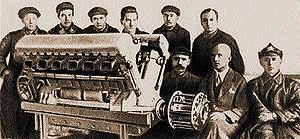Mikulin AM-34
The Mikulin AM-34 (initially: M-34 ) was a V 12-cylinder - aircraft engine from the Soviet Union .
history
It was an independent development based on the M-17 and was produced in series from 1932 to 1941. It is a water-cooled, vertical 60 ° V12 engine.
In contrast to the predecessor M-17, the M-34 had two exhaust valves and a more favorably shaped combustion chamber, which in turn made it possible to increase the compression to 6.2: 1 without the engine starting to knock with the existing fuels. The bore and stroke were retained so that existing production tools can continue to be used. Alexander Alexandrovich Mikulin completed his construction work in July 1930. The first experiments were started in October of the same year and lasted until August 1931. Between August 2 and November 7, 1931, the necessary 100-hour runs for approval were successfully carried out. The continuous output was initially 750 and the starting output 850 hp, with a weight of 535 kg. The engine was initially to be manufactured in Plant 26 in Rybinsk , where the M-17 was also manufactured. In the end, however, Plant 24 in Moscow was awarded the contract, where series production began at the beginning of 1932. The engine was then installed in the Polikarpow R-5 and the Tupolev TB-3 for flight tests and tested therein.
While the preparations for series production began, the development of a reduction gear, a radial compressor and an adjustable propeller began . This work was carried out by the Central Institute for Aircraft Engines in Moscow.
The variant with a reduction gear was given the designation M-34R and was completed in 1931. The type M-34N received a two-stage charger, which allowed a full pressure altitude of 5000 m. Difficulties arose repeatedly due to the manufacturing quality, especially with the connecting rods and the oil pump, which were complained about very often.
The type M-34RN, equipped with both a gearbox and a high-altitude loader, passed its endurance tests in 1934 and received approval as an aircraft engine after several 100-hour runs were completed without any problems. It was exhibited at the 2nd International Aviation Exhibition in Copenhagen in 1934 and received widespread attention, also in Milan in 1935 , although the specified engine performance was repeatedly doubted.
The long-distance records of the Tupolev ANT-25 , which was equipped with an M-34R, demonstrated the reliability and durability of the engine.
Considerations of building an engine with hanging cylinders were given up, but in 1935 the order was given to develop a variant with evaporative cooling, the AM-34RNF. There were also attempts with gasoline direct injection , the use of hydrogen as fuel and with a diesel variant.
In August 1936 a proposal was made to officially change the name of the engine from M-34 to AM-34 in order to better appreciate Mikulin's performance and to counteract any stagnation in development. This proposal was accepted on August 9, and Mikulin was appointed chief designer at the GAS-24 plant on August 11. So he was able to control the further development of the engine himself. He began with the construction of a reinforced version, the AM-34FRN, which should produce 950 hp at 5000 m. At the same time, the development of the AM-34FRNW, which was equipped with a long-distance shaft, began. Both projects were delayed, however, for which Mikulin was held responsible and was relieved of his post as chief designer on January 31, 1938. However, he remained the lead project engineer for the AM-34FRN. The engine was finally classified as ready for the troops in 1938 and delivery began.
First, the prototype of the heavy bomber TB-7 (Tupolev ANT-42) was equipped with the engine, which now developed a continuous output of 1050 hp at an altitude of 3050 m. The take-off power was 1200 hp. The single-speed radial compressor used now required up to 100 hp less power than its predecessor. There were two versions of the engine, the AM-34FRNA with four carburetors and the AM-34FRNB with six carburetors. The ANT-42 was later converted to the AM-34FRNB. The first TB-7 series aircraft received four AM-34FRNW in conjunction with a Klimow M-100 A as a central loader in the fuselage. In addition, the torpedo boats of the G5 series were each equipped with two of these engines
From 1938 on, the even further improved Mikulin AM-35 with modified cylinder heads was added until both were replaced by the Mikulin AM-38 from 1940 .
Versions
- AM-34
- AM-34F
- AM-34R
- AM-34RD
- AM-34N, 850 HP at 1850 / min ( Beriev MBR-2 , Polikarpow RZ )
- AM-34RN, 850 hp at 1850 rpm ( Tupolew TB-3 )
- AM-34NA
- AM-34RA
- AM-34RNA
- AM-34NB
- AM-34RNB
- AM-34RSO
- AM-34NW
- AM-34RNW-TK
- AM-34NF
- AM-34N2B
- AM-34FRN, 1200 hp at 2000 rpm ( Tupolew ANT-20 , Tupolew ANT-42 )
- AM-34FRNB
- AM-34RNFT
- AM-34FRNW, 1200 hp at 2000 rpm (first series of the TB-7 heavy bomber )
- AM-34FRNW-TK
- AM-34RNF, 1275 hp ( Ilyushin I-21 )
- GM-34
- GM-34F
- GM-34FN
- GM-34BP
- GM-34BS
- GM-34BT
Technical specifications
The use of coupling rods resulted in a different stroke of the two cylinder banks.
- Bore : 160 mm
- Stroke : 190 or 199 mm
- Displacement : 46.9 liters
- Weight: 670 kg
- Compression: 6: 1
